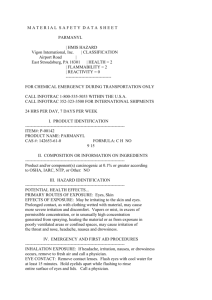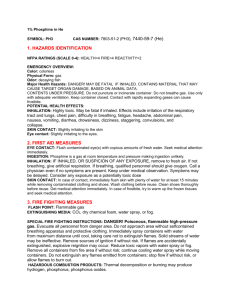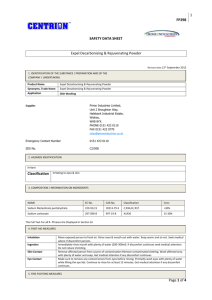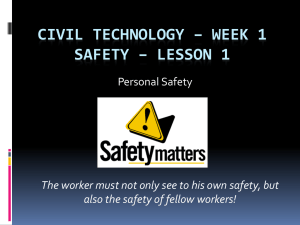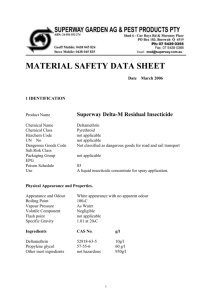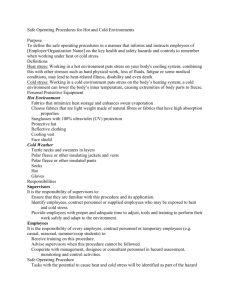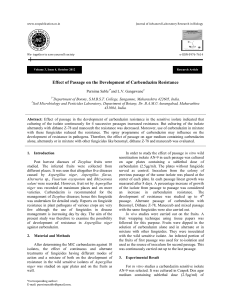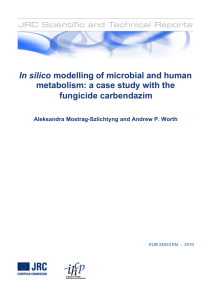Carbendazim 50% SC
advertisement
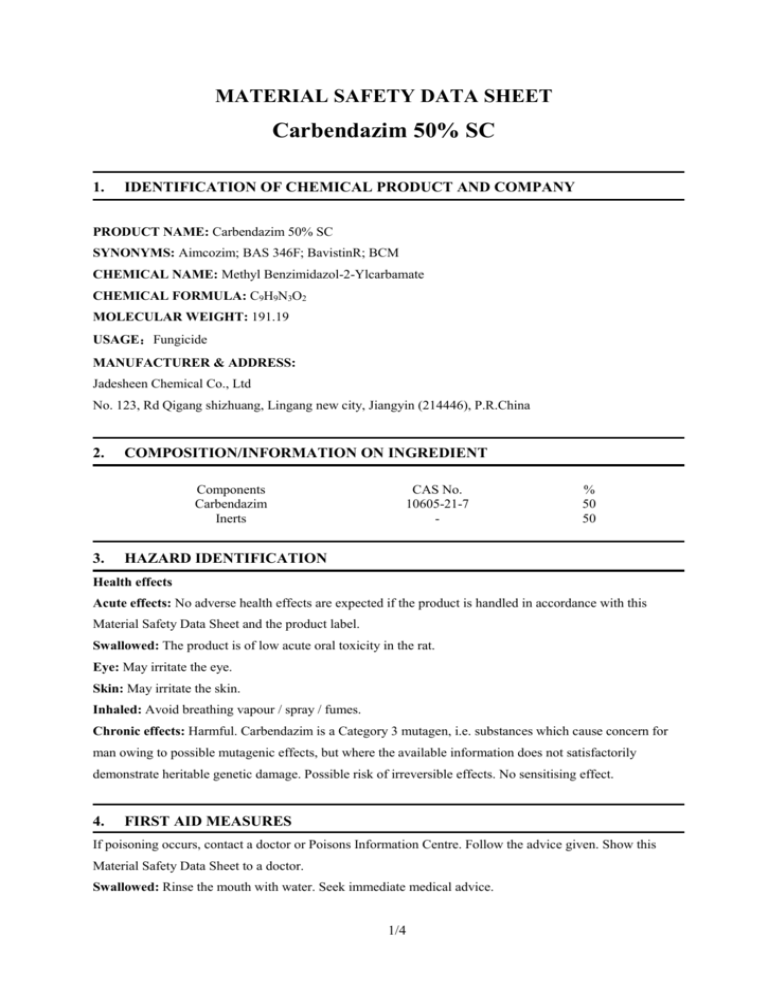
MATERIAL SAFETY DATA SHEET Carbendazim 50% SC 1. IDENTIFICATION OF CHEMICAL PRODUCT AND COMPANY PRODUCT NAME: Carbendazim 50% SC SYNONYMS: Aimcozim; BAS 346F; BavistinR; BCM CHEMICAL NAME: Methyl Benzimidazol-2-Ylcarbamate CHEMICAL FORMULA: C9H9N3O2 MOLECULAR WEIGHT: 191.19 USAGE:Fungicide MANUFACTURER & ADDRESS: Jadesheen Chemical Co., Ltd No. 123, Rd Qigang shizhuang, Lingang new city, Jiangyin (214446), P.R.China 2. COMPOSITION/INFORMATION ON INGREDIENT Components Carbendazim Inerts 3. CAS No. 10605-21-7 - % 50 50 HAZARD IDENTIFICATION Health effects Acute effects: No adverse health effects are expected if the product is handled in accordance with this Material Safety Data Sheet and the product label. Swallowed: The product is of low acute oral toxicity in the rat. Eye: May irritate the eye. Skin: May irritate the skin. Inhaled: Avoid breathing vapour / spray / fumes. Chronic effects: Harmful. Carbendazim is a Category 3 mutagen, i.e. substances which cause concern for man owing to possible mutagenic effects, but where the available information does not satisfactorily demonstrate heritable genetic damage. Possible risk of irreversible effects. No sensitising effect. 4. FIRST AID MEASURES If poisoning occurs, contact a doctor or Poisons Information Centre. Follow the advice given. Show this Material Safety Data Sheet to a doctor. Swallowed: Rinse the mouth with water. Seek immediate medical advice. 1/4 Eye: Immediately rinse eyes thoroughly, including under eyelids, with running water for at least 15 minutes. Seek medical advice. Skin: Immediately remove all contaminated clothing and footwear. Wash the skin thoroughly with soap and water. Seek medical advice. Inhaled: Remove from the source of vapour / spray / fumes. Remove to open space or fresh air. Keep warm and at rest. Seek medical advice. First aid facilities: Ensure washing facilities are available. Advice to doctor: Carbendazim is very rapidly absorbed and eliminated from the body. Treat according to symptoms. There is no known specific antidote. 5. FIRE FIGHTING MEASURES Extinguishing media: Water fog, fine water spray, foam or dry agent, carbon dioxide. Special fire fighting procedures: Firefighters should wear full body protective clothing with self contained breathing apparatus. Carbon monoxide and nitrogen oxides may be released. Prevent by any means possible spillage from entering drains or watercourses. Dispose of fire debris and contaminated extinguishing water in accordance with local regulations. Reactivity hazards: No hazards are expected if the material is handled, stored and used according to instructions and government regulations. 6. ACCIDENTAL RELEASE MEASURES Spillage or leak procedures: Personnel involved in clean up require adequate respiratory, skin and eye protection. Remove liquid mechanically. Prevent the material from entering drains or watercourses. Collect residue with absorptive material such as sand, soil or diatomaceous earth, and collect in properly labelled, sealed containers. Check local regulations for spill reporting and disposal waste. Waste disposal methods: Follow Avcare guidelines. Triple or preferably pressure rinse containers before disposal. Add rinsings to spray tank. Do NOT dispose of undiluted chemicals on-site. If recycling, replace cap and return clean containers to recycler or designated collection point. If not recycling, break, crush, or puncture and bury empty containers in a local authority landfill. If no landfill is available, bury the containers below 500 mm in a disposal pit specifically marked and set up for this purpose clear of waterways, desirable vegetation and tree roots. Empty containers and product should NOT be burnt. 7. HANDLING AND STORAGE Handling: Keep out of reach of children. Avoid contact with eyes, skin and clothing. Wear long sleeved overalls and gloves while handling. After handling and before eating, drinking or smoking, wash hands, arms and face thoroughly with soap and water. Storage: Store in the closed original container in a cool, well ventilated, locked place out of the reach of children. Do not store in direct sunlight. 2/4 8. EXPOSURE CONTROLS/PERSONAL PROTECTION Exposure limits: No exposure standard has been assigned by the National Occupational Health and Safety Commission Engineering controls: Use only in well-ventilated areas. Personal protection Clothing: wear suitable protective clothing such as cotton overalls buttoned to the neck and wrist. Eyes: Wear safety goggles. Hands: Wear elbow-length PVC or nitrile gloves. Do NOT eat, drink or smoke until after washing. Wash thoroughly after handling. After each day’s use wash personal protective equipment, including gloves, goggles, respirator face piece and contaminated clothing. Do NOT smoke in the working areas. Re-entry period Do not allow entry into treated areas until the spray deposits have dried. When prior entry is necessary, wear cotton overalls buttoned to the neck and wrist and elbow-length PVC gloves. Clothing must be laundered after each day’s use. For glasshouses and other confined areas, do not re-enter until spray deposits have dried and area has been thoroughly ventilated. 9. PHYSICAL AND CHEMICAL PROPERTIES Physico-Chemical Properties Color Off-white State / Form Liquid Odor Odorless Density 10. 1.2 STABILITY AND REACTIVITY Chemical stability: Stable under normal conditions of use. No dangerous reaction known under normal conditions. Hazardous polymerisation: None Conditions to avoid: Extreme heat and fire Incompatible materials: None known Hazardous decomposition products: Thermal decomposition may produce toxic by-products of carbon and nitrogen. 11. TOXICOLOGICAL INFORMATION Acute toxicity: LD50 >5000 mg/kg Rat dermal: >2000 mg/kg 3/4 Rat inhalation: LC50 5.2 mg/L/4hr 12. ECOLOGICAL INFORMATION Protection of livestock: Carbendazim is of low toxicity to bees. Protection of wildlife, fish, crustaceans and environment: Do NOT contaminate streams, rivers or waterways with this product or the used containers. 13. DISPOSAL CONSIDERATIONS Dispose of empty container by wrapping in paper, placing in plastic bag and putting in the garbage. DO NOT burn empty containers or product. 14. TRANSPORT INFORMATION Label class: 9 UN-Number: 3082 Packaging group: III 15. REGULATORY INFORMATION Not classified as hazardous according to criteria of the National Occupational Health and Safety Commission. 16. OTHER INFORMATION STATEMENT NOTICE The information and recommendations contained herein is believed to be reliable and are presented in good faith by the supplier. The information is supplied upon the condition that users and handlers of the product will make their own determination as to its suitability for their purpose prior to use. In no event will the supplier be responsible for damages of any nature concerning the handling and use of this product. Handlers and users of the product assume all risks and liabilities arising from its handling, use or application. 4/4
